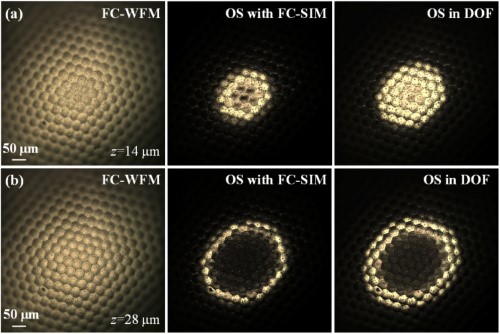
Conventional wide-field microscopy (WFM) cannot provide optical sectioning (OS) images that are required for 3D volumetric reconstruction. The reason lies in the fact that the out-of-focus signals are always coupled within the in-focus plane. By introducing structured illumination microscopy (SIM), researchers have achieved removing the out-of-focus components from the in-focus plane in full color (FC).
However, the current FC-SIM approach needs three phase-shifted raw images for each focused plane and hundreds of axial-scanned planes. This approach causes a significant number of raw images and thus putting a heavy burden on data storage and processing time cost. How to release such a burden is still a question.
Recently, a research team led by Prof. YAO Baoli at State Key Laboratory of Transient Optics and Photonics, Xi'an Institute of Optics and Precision Mechanics (XIOPM) of the Chinese Academy of Sciences (CAS), has reported a deep learning scheme FC-WFM-Deep to obtain full-color optical sectioning images for wide-field microscopy directly.
In contrast to the FC-SIM approach, the reconstruction data size is 21-fold smaller, and the in-focus depth is doubled. This work was published in the journal Biomedical Optics Express.

Imaging of a compound eye at different depths of (a) 14 μm and (b) 28 μm acquired with FC-WFM method, OS with FC-SIM method, and the OS in DOF with proposed FC-WFM-Deep, respectively. (Image by XIOM)
FC-WFM-Deep fully exploits the unique high resolution and full-color capabilities of SIM. Efficiently, the deep learning network only needs training to a single wide-field frame. After training, high-quality images with optical sectioning, considerable in-focus depth, and full-color can be directly acquired from the wide-field frame.
FC-WFM-Deep has a comparable imaging quality to FC-SIM in terms of spatial resolution and dimensions. Beyond that, the data required for FC-WFM-Deep in full-color 3D reconstruction can be 21-fold less than that for FC-SIM.
FC-WFM-Deep significantly reduces the 3D data acquisition requirements without losing detail and improves the 3D imaging speed by extracting the optical sectioning in the depth-of-field (DOF). This cost-effective and convenient method offers a promising tool to observe 3D color biological samples with high precision.

86-10-68597521 (day)
86-10-68597289 (night)

52 Sanlihe Rd., Xicheng District,
Beijing, China (100864)

